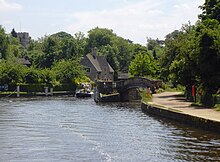| Revision as of 12:34, 17 November 2012 editMichael Glass (talk | contribs)Extended confirmed users11,667 edits Dimensions of the lock as per the Environment Agency← Previous edit | Revision as of 23:38, 19 November 2012 edit undoMichael Glass (talk | contribs)Extended confirmed users11,667 edits Reference to the Environment Agency added. Distances in km and miles as per the agency. Reflist relocated.Next edit → | ||
| Line 56: | Line 56: | ||
| * ] | * ] | ||
| * ] | * ] | ||
| ⚫ | ==References== | ||
| ⚫ | {{Reflist}} | ||
| ==External links== | ==External links== | ||
| Line 68: | Line 65: | ||
| {{River item line|upstream=] (road)|downstream=] (road)}} | {{River item line|upstream=] (road)|downstream=] (road)}} | ||
| {{River lock start|River=]}} | {{River lock start|River=]}} | ||
| {{River lock line|upstream=]<br/> |
{{River lock line|upstream=]<br/> {{convert|3.73|km|abbr=on}} <ref name="EnvAgency2" > {{cite web |url= http://www.environment-agency.gov.uk/homeandleisure/recreation/131811.aspx |title=Environment Agency Distances between locks on the River Thames |date=19 November 2012 |work=web page |publisher=Environmental Agency |accessdate=20 November 2012}} Distances given in km</ref>|downstream=]<br/> {{convert|2.70|km|abbr=on}}<ref name="EnvAgency2" />|location=SP525036}} | ||
| {{End box}} | {{End box}} | ||
| ⚫ | ==References== | ||
| ⚫ | {{Reflist}} | ||
| ] | ] | ||
Revision as of 23:38, 19 November 2012
| Iffley Lock | |
|---|---|
 Iffley Lock from downstream Iffley Lock from downstream | |
| 51°43′42.45″N 1°14′25.21″W / 51.7284583°N 1.2403361°W / 51.7284583; -1.2403361 | |
| Waterway | River Thames |
| County | Oxfordshire |
| Maintained by | Environment Agency |
| Operation | Hydraulic |
| First built | 1631 |
| Latest built | 1927 |
| Length | 46.96 m (154 ft 1 in) |
| Width | 6.47 m (21 ft 3 in) |
| Fall | 0.81 m (2 ft 8 in) |
| Above sea level | 178' |
| Distance to Teddington Lock | 91 miles |
| Iffley Lock | ||||||||||||||||||||||||||||||||||||||||||||||||||||||||||||||||||||||||||||||||||||||||||||||||||||||||||||||||||||||||||||||||||||||||||||||||||||||||||||||||||||||||||||||||||||||||||||||||||||||||||||||||||||||||||||||||||||||||||||||
|---|---|---|---|---|---|---|---|---|---|---|---|---|---|---|---|---|---|---|---|---|---|---|---|---|---|---|---|---|---|---|---|---|---|---|---|---|---|---|---|---|---|---|---|---|---|---|---|---|---|---|---|---|---|---|---|---|---|---|---|---|---|---|---|---|---|---|---|---|---|---|---|---|---|---|---|---|---|---|---|---|---|---|---|---|---|---|---|---|---|---|---|---|---|---|---|---|---|---|---|---|---|---|---|---|---|---|---|---|---|---|---|---|---|---|---|---|---|---|---|---|---|---|---|---|---|---|---|---|---|---|---|---|---|---|---|---|---|---|---|---|---|---|---|---|---|---|---|---|---|---|---|---|---|---|---|---|---|---|---|---|---|---|---|---|---|---|---|---|---|---|---|---|---|---|---|---|---|---|---|---|---|---|---|---|---|---|---|---|---|---|---|---|---|---|---|---|---|---|---|---|---|---|---|---|---|---|---|---|---|---|---|---|---|---|---|---|---|---|---|---|---|---|---|---|---|---|---|---|---|---|---|---|---|---|---|---|---|---|
| Legend | ||||||||||||||||||||||||||||||||||||||||||||||||||||||||||||||||||||||||||||||||||||||||||||||||||||||||||||||||||||||||||||||||||||||||||||||||||||||||||||||||||||||||||||||||||||||||||||||||||||||||||||||||||||||||||||||||||||||||||||||
| ||||||||||||||||||||||||||||||||||||||||||||||||||||||||||||||||||||||||||||||||||||||||||||||||||||||||||||||||||||||||||||||||||||||||||||||||||||||||||||||||||||||||||||||||||||||||||||||||||||||||||||||||||||||||||||||||||||||||||||||
Iffley Lock is a lock on the River Thames in England near the village of Iffley, Oxfordshire. It is on the southern outskirts of Oxford. The original lock was built by the Oxford-Burcot Commission in 1631 and the Thames Navigation Commission replaced this in 1793. The lock has a set of rollers to allow punts and rowing boats to be moved between the water levels.
In addition the lock and weir streams there is stream further to the east which used to be the Mill Stream.
The weir is downstream of the lock, where the weir stream is joined by the mill stream.
History
A weir was owned by Lincoln College as early as 1302 and this weir may have carried the bridge which is referenced earlier than this. Iffley Lock was the pound lock furthest upstream that was built by the Oxford-Burcot Commission in 1631. In 1790 the Thames Commissioners took over Iffley and the other Oxford-Burcot locks at Sandford and Swift Ditch. The Commission rebuilt the lock in 1793, and the keeper was instructed to take tolls for "punts, pleasure boats, skiffs and wherries" at a charge of sixpence for punts and skiffs and one shilling for four oared craft. However access to the lock was awkward for barge traffic heading for the Thames and Severn Canal which had to enter backwards and take down their masts. Improvements and enlargements were made to the lock in 1802 and 1806 and the stone lockhouse was built in 1810. In 1826, it was ordered that no craft should pass through the lock during the hours of divine service. In the middle of the 19th century there was a problem with water levels below the water and a witness to a parliamentary enquiry reported that cows and horses were sometimes driven into the river to create sufficient draught. The lock was repaired in 1866, and ten years later the lock was being blamed for flooding in Oxford. Although the boat slide was promised in 1885, at the same time the Thames Conservancy were considering removing the lock. However there were many petitions to retain it and it survived. The latest rebuilding took place in 1927.
Access to the lock
The lock can be reached on foot on the track from Donnington Bridge on the western side.
Reach above the lock


The river at this point and around Oxford in general is sometimes known as the Isis. Donnington Bridge crosses the river upstream of the lock and then the River Cherwell joins the Thames on the northern side. The university college boathouses line the bank on the northern side, followed by Christ Church Meadow. This upstream stretch of the river is used for rowing, and is the location of the University rowing regattas of Torpids and Summer Eights. After Christchurch Meadow is Folly Bridge where are the landing stages for pleasure boats. After Folly Bridge, the river runs through suburbs where it is crossed by Grandpont Bridge. Beyond this is the Gasworks Bridge, a converted railway bridge, and the Osney Rail Bridge.
The Thames Path stays on the western side towards South Hinksey until it reaches Osney Lock.
See also

External links
| Next crossing upstream | River Thames | Next crossing downstream |
| Donnington Bridge (road) | Iffley Lock | Isis Bridge (road) |
| Next lock upstream | River Thames | Next lock downstream |
| Osney Lock 3.73 km (2.32 mi) |
Iffley Lock Grid reference: SP525036 |
Sandford Lock 2.70 km (1.68 mi) |
References
- ^ "Environment Agency Dimensions of locks on the River Thames". web page. Environmental Agency. 8 November 2012. Retrieved 17 November 2012. Dimensions given in metres
- Fred. S. Thacker The Thames Highway: Volume II Locks and Weirs 1920 - republished 1968 David & Charles
- ^ "Environment Agency Distances between locks on the River Thames". web page. Environmental Agency. 19 November 2012. Retrieved 20 November 2012. Distances given in km